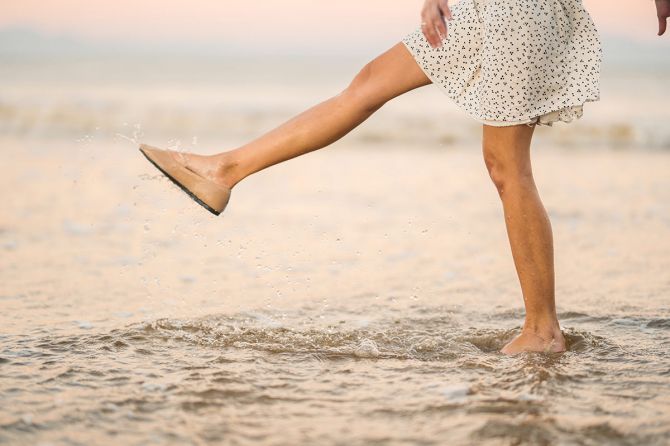Chafing is an unpleasant reality that many people ignore, and it can truly mess up your lifestyle, warns Maharukh T Rustomjee, chief scientist and managing partner, Amaterasu Lifesciences LLP.

As summer approaches, skin irritations, boils, and itchy rashes are set to make their presence felt.
Travelling and spending long hours in uncomfortable clothes can become cumbersome, especially in humid areas, and may lead to serious chafing.
Chafing is caused by increased friction from skin-on-skin or skin-on-fabric contact and is frequently accompanied by rashes, pain, stinging, or burning sensation.
The effects are adverse during the summer because the skin traps more moisture as a result of excessive sweating, and wet skin which leads to chafing.
The good news is that this is not a symptom of a serious medical problem and can be easily prevented.
Chafing can be caused by wearing ill-fitting clothes, especially tight underwear, is one of the most common causes of jockitch in men.
In case of women, bras and underwear, can cause under-bra and rub rashes.
Chafing is more common in people who engage in intense workouts owing to the frequent rubbing of skin on garments.
Obese people are also more susceptible to chafing, especially in the groin, inner thigh areas etc.
For most women, their menstrual cycles also make them vulnerable to period rashes and chafing caused by sanitary pads, something that is indispensable for them!
Lastly, athletes are also another set of people most prone to chafing, thanks to long hours spent in outdoors, in tight sportswear and activity gear. The humid weather further aggravates skin rashes in skin folds where it's moist.
The problem with chafing is that many people take it lightly or trivialise the problem. Some of them notice chafing when they take a bath, as the chafed skin stings with touch of water or soap.
If not addressed early on, chafing caused under any of the above scenarios, may lead to tearing of skin and later may cause infection that would require medical intervention.
These are some effective ways to deal with chafing and protect your skin.
1. Maintain clean and dry skin
Damp or sweaty skin is more prone to harm. It is advisable to wear comfortable garments that can help keep skin clean and dry.
It is essential to maintain appropriate hygiene habits in order to avoid skin infections.
Don't miss showers, and be sure to dry your body after each one. If you observe any indications of rashes or chafing, take extra care to keep the area dry to prevent germs from forming.
2. Dress right
Fabric and clothing play an important role in how the skin breathes and adjusts to temperatures/environment outside.
Wearing overly tight or ill-fitting clothes, with synthetic fabrics, cause rashes and chafing.
For people who work out, it is recommended that they wear clothes which are comfortable and made out of sweat-wicking materials like nylons and polyesters.
Repeating clothes that have been sweaty and not washed, is never a good personal hygiene practice and will only invite a slew of additional skin problems.
3. Using anti-chafing products
Use of anti-chafing products like skin gels and anti-chafing creams on the chafe prone areas like inner thighs, groin, armpits, underarm, underbra, toes, etc can reduce the risk of chafing.
While petroleum jelly based products have been used conventionally to prevent chafing that wear out very fast, the new age skincare products with silicone based barrier protection technology, have proven to be excellent in preventing chafing and providing long lasting protection to skin.
4. Stay hydrated
The salt in your perspiration or sweat that is left behind after the liquid part has evaporated is one of the major causes of this skin problem, and these salt leftovers frequently intensify the friction and inflame the skin.
It can be extremely uncomfortable if chafing is not managed promptly, resulting in swelling, crusting, bleeding, or even skin infections, depending on the severity.
By staying hydrated the salt in your perspiration is reduced and hence reduces the risk of chafing
5. Consult an expert
Despite your best efforts, skin chafing may occur for reasons beyond your control.
Inspect your skin regularly for signs of infections, redness, blisters, lesions, abrasions, and cuts. If you notice any changes in the colour of your skin, see a dermatologist right away.
Delaying treatment may cause the infection to spread and the surrounding healthy skin to break.
Chafing is an unpleasant reality that many people ignore and it can truly mess up your day-to-day lifestyle.
One must fight both friction and moisture to avoid being rubbed raw.
Chafing can be easily prevented or cured with a proactive approach and is not a stressful problem when dealt with an effective way.
Disclaimer: All content and media herein is written and published online for informational purposes only. It is not a substitute for professional medical advice. It should not be relied on as your only source for advice.
Please always seek the guidance of your doctor or a qualified health professional with any questions you may have regarding your health or a medical condition. Do not ever disregard the advice of a medical professional, or delay in seeking it because of something you have read herein.
If you believe you may have a medical or mental health emergency, please call your doctor, go to the nearest hospital, or call emergency services or emergency helplines immediately. If you choose to rely on any information provided herein, you do so solely at your own risk.
Opinions expressed herein cannot necessarily provide advice to fit the exact specifics of the issues of the person requesting advice.












